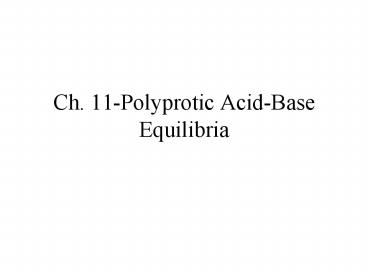Ch. 11Polyprotic AcidBase Equilibria - PowerPoint PPT Presentation
1 / 18
Title:
Ch. 11Polyprotic AcidBase Equilibria
Description:
Amino acid building blocks of proteins have the general structure: ... A zwitterion is a molecule with both positive and negative charges. Amino Acids ... – PowerPoint PPT presentation
Number of Views:56
Avg rating:3.0/5.0
Title: Ch. 11Polyprotic AcidBase Equilibria
1
Ch. 11-Polyprotic Acid-Base Equilibria
2
Proteins as Polyprotic Acids and Bases
Amino acids
Peptides/proteins
3
Amino Acids
- Amino acid building blocks of proteins have the
general structure - R is a different side chain for each amino acid
- At low pH, both the ammonium and carboxyl groups
are protonated. At high pH, neither is. - Were going to look at leucine as an example
A zwitterion is a molecule with both positive and
negative charges
4
Amino Acids
5
Leucine
- The side group on leucine is an isobutyl group
- Equilibrium constants are for these reactions
- Well now calculate pH for solutions of these
H2L
HL
L-
6
H2L (Acid form)
- Whats the pH of a 0.0500 M solution of H2L
- Because Ka14.69x10-3 and Ka21.79x10-10, were
going to assume that H2L acts as a monoprotic
acid - We can check our assumption by calculating L-
H2L (0.050-x)
HL (x)
H (x)
7
L- (Base Form)
- Whats the pH of a 0.0500 M solution of L-?
- Again, because Kb2ltltKb1were going to assume that
H2L acts as a monoprotic acid - We can check our assumption by calculating H2L
8
HL (Middle Form)
- What is the pH of a solution of 0.050 M HL?
- HL is amphiprotic, meaning it can both donate and
accept a proton - Wed expect this solution to be slightly acidic
because Ka1 is larger than Kb2, but we have to
use the systematic treatment to determine pH
9
Example-Leucine (HL)
- Reactions
- Charge balance
- Equilibrium constants
10
Example-Leucine (cont)
- If we assume that neither reaction proceeds very
far because both Ks are small, then we can put
the Formal concentration into HL
11
Example-Leucine (cont)
- If HLF0.050 M
- We can again check our assumptions
- The assumptions were valid, both of these are
much lower concentration than HL (0.050 M)
12
Simplified Equation
- Some conditions usually exist to simplify the
general equation - If Ka2(F)gtgtKw, than the 2nd term in the numerator
can be dropped and if Ka1ltltF, the 1st term in the
denominator can also be neglected - After canceling F and doing some algebra
- This eqn usually works for the intermediate form
of a diprotic acid Here, it gives pH6.04
instead of 6.06
13
Example-KHP
- Potassium hydrogen phthalate is a salt of the
intermediate form of phthalic acid. Calculate
the pH of 0.10 and 0.010 M KHP solution
H2P (Phthalic acid)
HP- (monohydrogen phthalate)
P2- (phthalate)
(For any molarity)
14
Summary of Solving Diprotics
- Solving for H2A
- Treat as monoprotic with KaKa1
- Solving for HA-
- Use the approximation HA-F
- Solving A2-
- Treat A2- as monobasic with KbKb1
15
Diprotic Buffers
- A buffer from a diprotic (or polyprotic) acid is
treated the same as for a monoprotic - For H2A, we can write two Henderson-Hasselbalch
equations, both of which must be true.
16
A Buffer System
- What is the pH of a solution prepared by
dissolving 1.0 g KHP and 1.20 g Na2P in 50.0 mL
water? - We know A2- and HA-, so we use pK2
- Since volume cancels anyway, we just used moles
17
Polyprotic Acids and Bases
- Polyprotics essentially can be treated similar to
diprotics - H3A is treated as a monprotic with KaK1
- H2A- is treated as an intermediate form
- HA2- is treated as an intermediate form
- A3- is treated as monobasic with KbKb1
18
Graphic of Treating Triprotics































